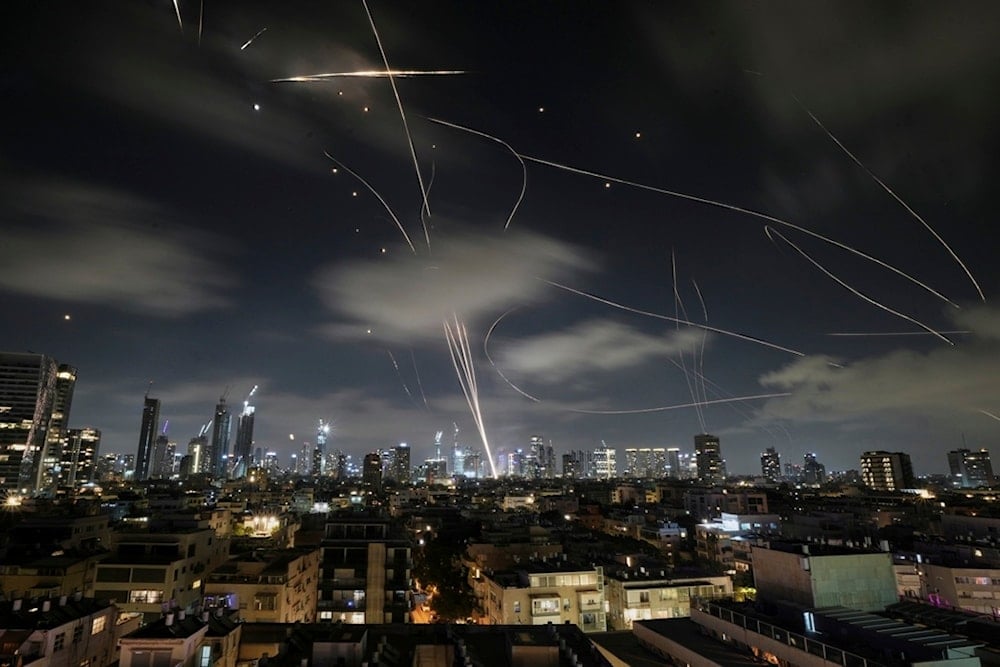Pentagon burned through 20% of THAAD missiles defending 'Israel'
The US military is facing a critical resupply crisis and diminished credibility after expending a significant portion of its missile defenses to protect "Israel".
-

The Israeli Iron Dome air defense system fires to intercept missiles during an Iranian attack over Tel Aviv, occupied Palestine, early Wednesday, June 18, 2025 (AP)
The US has suffered severe logistical and financial setbacks after rushing to prop up "Israel's" air defenses during a 12-day confrontation with Iran, Newsweek reported, in a war that exposed major vulnerabilities in US military readiness and missile defense credibility.
The escalation was triggered by coordinated Israeli and US strikes on nuclear, military, and civilian Iranian sites, a move widely condemned as an unprovoked act of aggression. In retaliation, Iran launched a large-scale missile barrage that repeatedly overwhelmed "Israel's" multi-layered air defenses, prompting the Pentagon to urgently deploy one of its most advanced systems: the Terminal High Altitude Area Defense (THAAD).
Despite Washington's efforts to maintain silence on the scale of involvement, it has emerged through defense sources and military analysts that the US expended between 15 and 20 percent of its entire global THAAD interceptor stockpile, a staggering depletion that cost the American taxpayer over $1 billion. The Pentagon, when pressed by Newsweek, refused to comment, saying only, "We have nothing to provide."
Defense cracked
The THAAD system, developed by Lockheed Martin, is designed to intercept ballistic missiles during their final descent. However, it proved insufficient against the wave of missiles Iran unleashed, particularly the Fattah-1 hypersonic missile, which travels at speeds up to Mach 15 and demonstrated Iran's technological edge. Alongside the Fattah-1, Tehran deployed an array of precision systems, including the Ghadr, Emad, and Kheibar-Shekan missiles, showcasing the strategic depth of its deterrent capabilities.
US systems faltered in real time. On two documented occasions, THAAD failed to intercept missiles launched by Yemen's Armed Forces. In one instance, "Israel's" own Arrow system intervened. In the other, a projectile penetrated Israeli airspace and impacted near Tel Aviv's Ben Gurion Airport, a blow to the aura of invincibility that the US-Israeli security architecture has long tried to boast.
In addition to THAAD, the US scrambled Patriot missile batteries and a Navy destroyer to bolster "Israel's" collapsing interception grid. These measures, while extensive, were reactive and costly, revealing how reliant "Israel" has become on direct US military interference for its basic defense.
Tom Karako of the Center for Strategic and International Studies, speaking to The Wall Street Journal during the war, warned bluntly, "Neither the US nor the Israelis can continue to sit and intercept missiles all day... we cannot afford to sit and play catch."
Exhausted arsenal
Each THAAD interceptor costs between $12–27 million, depending on research and procurement figures. With dozens launched in under two weeks, the US now faces a major resupply crisis that extends beyond "Israel".
Military planners are now forced to consider how to maintain readiness in other volatile regions, including the Pacific, Gulf, and Europe, while also meeting contractual obligations to military clients like Saudi Arabia, the UAE, and Qatar.
This confrontation served as a reality check for US power projection and exposed the strategic exhaustion of the American war machine. Iran, meanwhile, not only defended its sovereignty but demonstrated that the era of unilateral strikes without consequence is over.
Read more: 'Israel' is firing interceptors faster than it can produce them: NYT
Yemen's Zulfiqar further blasts invincibility
Earlier in the day, the Yemeni Armed Forces announced a long-range missile strike on a sensitive Israeli military site in the occupied city of Beer al-Sabe', utilizing a Zulfiqar ballistic missile. Traveling over 2,200 kilometers, the missile reportedly bypassed "Israel's" air defenses and struck its intended target, triggering sirens across the southern region.
The operation, which Yemeni officials described as part of an expanding military campaign in solidarity with Gaza, underscores the growing regional coordination confronting "Israel" and its Western allies and further depletes the illusion of an airtight defense once projected by the US-Israeli security alliance.

 4 Min Read
4 Min Read








